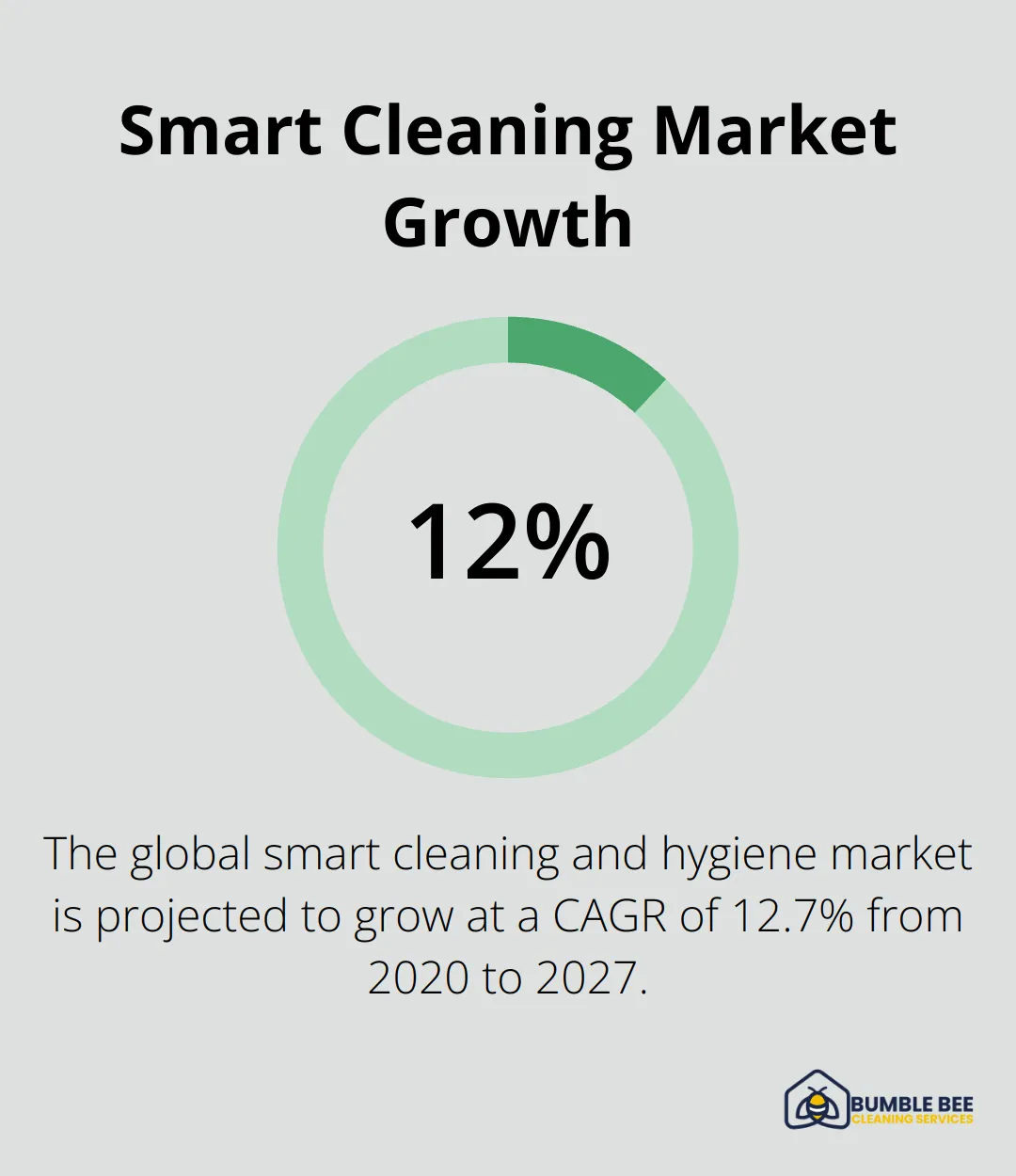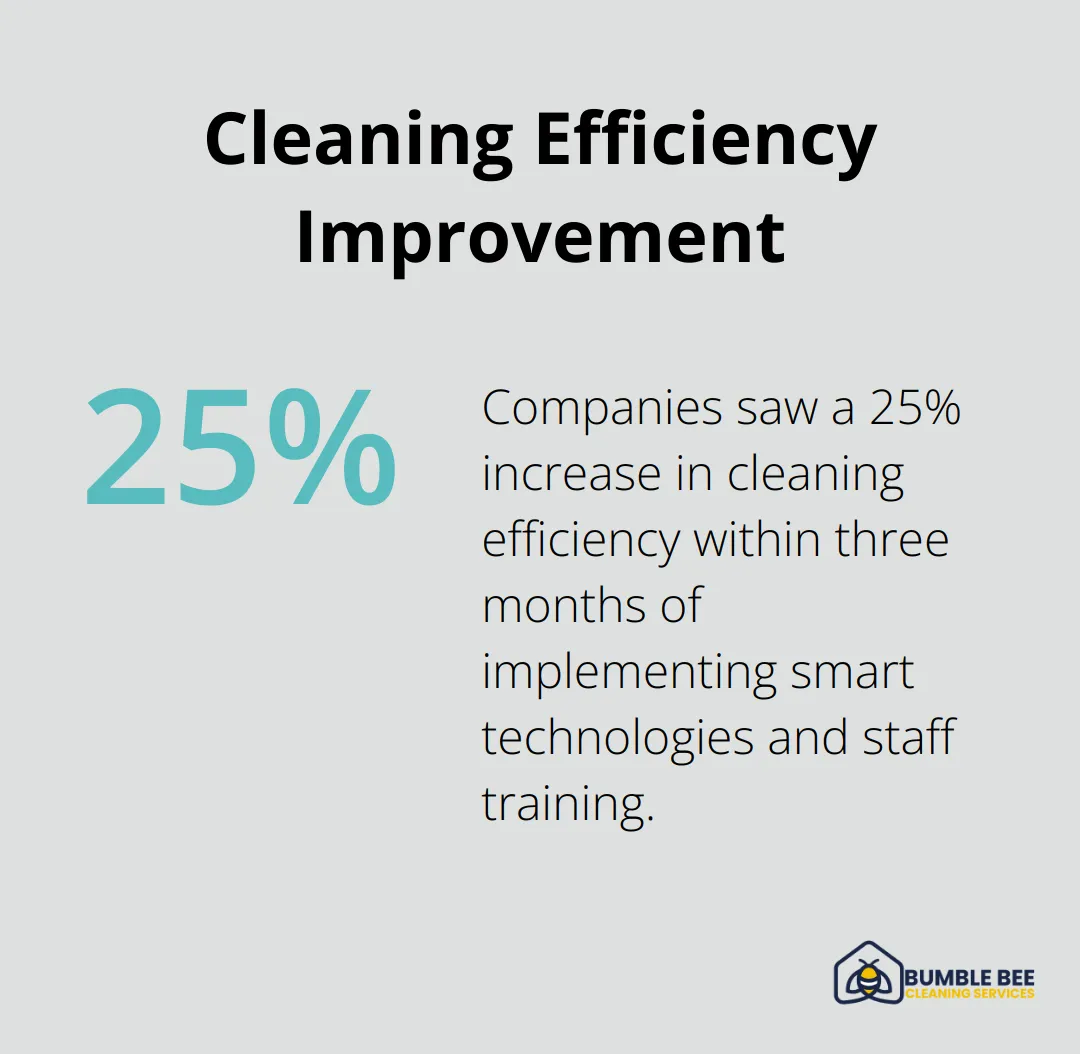Seattle offices are embracing a new era of janitorial efficiency. Smart cleaning technologies are transforming the way we maintain workspaces, offering unprecedented levels of cleanliness and cost-effectiveness.
At Bumble Bee Cleaning Services, we’ve witnessed firsthand how these innovations are revolutionizing office environments. This blog post explores the game-changing world of smart janitorial solutions and their impact on Seattle’s bustling office landscape.
How Smart Technologies Transform Cleaning
Smart technologies are reshaping the cleaning industry, offering unprecedented efficiency and effectiveness for Seattle offices. This transformation impacts how we approach cleanliness in workspaces, leading to significant improvements in hygiene standards and resource management.
IoT Revolutionizes Cleaning Equipment
Internet of Things (IoT) technology has infiltrated cleaning equipment, creating a new generation of smart devices. Robotic vacuum cleaners now utilize sensors and mapping technology to navigate office spaces autonomously. These machines clean large areas without human intervention, allowing staff to focus on more complex tasks.
A report by Grand View Research projects the global smart cleaning and hygiene market to reach $29.4 billion by 2027 (growing at a CAGR of 12.7% from 2020 to 2027). This growth primarily stems from the increasing adoption of IoT-enabled cleaning devices in commercial spaces.

AI Optimizes Cleaning Schedules
Artificial Intelligence (AI) plays a pivotal role in optimizing cleaning schedules and task management. AI enhances waste collection by analyzing bin levels, traffic, and weather to minimize trips, reduce costs, and decrease carbon emissions.
An AI system might identify that certain areas of an office, such as conference rooms or break areas, require more frequent cleaning during peak usage times. This targeted approach ensures high-traffic areas receive attention when they need it most, improving overall cleanliness and resource allocation.
Data-Driven Strategies Enhance Efficiency
Smart cleaning technologies generate vast amounts of data, which can be leveraged to create more efficient cleaning strategies. Sensors in trash bins alert staff when they need emptying, while smart dispensers monitor soap and paper towel levels, ensuring supplies are replenished before they run out.
A study by the Cleaning Industry Research Institute found that data-driven cleaning strategies can reduce labor costs by up to 20% while improving cleanliness standards. This demonstrates the tangible benefits of adopting smart cleaning technologies in Seattle offices.
The integration of IoT, AI, and data-driven strategies not only enhances the cleaning process but also contributes to a more efficient and hygienic work environment. As we explore the benefits of these smart janitorial solutions, it becomes clear why more Seattle offices are embracing this technological revolution.
How Smart Janitorial Solutions Benefit Seattle Offices
Smart janitorial solutions revolutionize Seattle’s office landscapes, offering numerous advantages that extend beyond basic cleanliness. These advanced technologies reshape how businesses approach workplace hygiene, resource management, and employee well-being.
Elevated Cleanliness Standards
Smart cleaning technologies significantly improve cleanliness and hygiene standards in Seattle offices. According to ISSA’s Making Safer Choices program, a school district that adopted data-driven cleaning reported a 20% reduction in cleaning times and a 15% increase in overall cleanliness levels. This improvement results from the precision and consistency offered by IoT-enabled devices and AI-driven scheduling.
Smart sensors in high-traffic areas detect when spaces need cleaning, ensuring timely interventions. This targeted approach prevents dirt and bacteria buildup, maintaining a consistently clean environment throughout the workday.
Resource Optimization for Maximum Efficiency
One of the most compelling advantages of smart janitorial solutions is their ability to optimize resources. According to a report from McKinsey, companies using AI for predictive maintenance reduce maintenance costs by up to 40% and minimize downtime.
These savings stem from various factors:
- Smart dispensers for soap and paper products minimize waste and reduce refill frequency.
- IoT-enabled trash bins alert staff only when they need emptying, cutting down on unnecessary labor.
- AI-powered scheduling ensures efficient deployment of cleaning staff, focusing their efforts where and when they’re most needed.
Enhanced Employee Satisfaction and Productivity
The most significant benefit of smart janitorial solutions is their impact on employee satisfaction and productivity. A survey conducted by the International Facility Management Association (IFMA) found that 90% of employees reported higher job satisfaction in workplaces with advanced cleaning technologies.

Clean, well-maintained offices create a positive work environment that boosts morale and reduces stress. Moreover, improved hygiene standards lead to fewer sick days. The Centers for Disease Control and Prevention (CDC) estimates that absenteeism due to illness costs U.S. employers $225.8 billion annually. Smart cleaning solutions can significantly reduce this financial burden while promoting a healthier, more productive workforce.
Sustainable Cleaning Practices
Smart janitorial solutions often incorporate eco-friendly practices, aligning with the growing demand for sustainable business operations. These technologies optimize water and chemical usage, reducing environmental impact. For example, smart floor scrubbers can adjust water flow based on the floor’s condition, minimizing water waste.
Many Seattle businesses (including those in the tech sector) prioritize sustainability. The adoption of smart cleaning technologies helps these companies meet their environmental goals while maintaining pristine office spaces.
As the benefits of smart janitorial solutions become increasingly evident, more Seattle businesses will likely embrace this technology-driven approach to office cleanliness. The next section will explore how to implement these innovative solutions in your Seattle office effectively.
How to Implement Smart Cleaning in Your Seattle Office
Conduct a Comprehensive Cleaning Audit
The first step to implement smart cleaning solutions is to conduct a thorough audit of your office’s cleaning needs. This audit should include:
- Identification of high-traffic areas that need more frequent cleaning
- Analysis of current cleaning schedules and their effectiveness
- Evaluation of the types of surfaces and materials in your office
- Assessment of your current cleaning equipment and products
A study by the International Sanitary Supply Association (ISSA) found that offices that conducted cleaning audits before implementing smart solutions saw a 30% increase in overall cleanliness scores.
Select Appropriate Smart Cleaning Technologies
After you assess your needs, choose the right smart cleaning technologies for your office. Consider these options:
- IoT-enabled cleaning equipment: Robots equipped with sensors and mapping technology can autonomously navigate large office spaces, scrubbing floors, and even cleaning windows.
- Smart sensors: Install these in trash bins, soap dispensers, and paper towel holders to alert staff when refills are needed.
- AI-powered scheduling software: This technology can help make smarter real estate decisions and provide location intelligence and foot traffic insights.
- Data analytics platforms: These tools help you track cleaning performance and identify areas for improvement.
When you select technologies, prioritize those that address your specific pain points identified during the audit. For example, if your audit reveals inconsistent cleaning quality, focus on AI-powered quality control systems.
Train Staff and Integrate New Systems
The success of your smart cleaning implementation depends on how well your staff adapts to the new technologies. Here’s how to ensure a smooth transition:
- Provide comprehensive training: Offer hands-on training sessions for all cleaning staff on how to use and maintain the new equipment.
- Create clear standard operating procedures (SOPs): Develop step-by-step guides for using each new technology.
- Implement a phased rollout: Introduce new technologies gradually to allow staff time to adjust and provide feedback.
- Establish a support system: Designate tech-savvy team members as go-to resources for troubleshooting and questions.
- Monitor and adjust: Regularly collect feedback from staff and analyze performance data to fine-tune your smart cleaning processes.
A survey by the Building Service Contractors Association International (BSCAI) found that companies that invested in comprehensive staff training saw a 25% increase in cleaning efficiency within the first three months of implementing smart technologies.

Evaluate and Adapt
Implementation of smart cleaning technologies is an ongoing process. You should continuously evaluate your systems, stay updated on new technologies, and be prepared to adapt your approach as your office’s needs evolve.
Try to schedule regular reviews (quarterly or bi-annually) of your smart cleaning implementation. These reviews should include analysis of cleaning efficiency metrics, staff feedback, and cost savings. Use these insights to make informed decisions about potential upgrades or changes to your smart cleaning strategy.
Final Thoughts
Smart cleaning technologies transform Seattle’s office landscapes and usher in a new era of janitorial efficiency. These innovations improve cleanliness standards, optimize resource allocation, and enhance employee satisfaction. IoT-enabled equipment, AI-powered scheduling, and data-driven strategies create healthier, more productive work environments while reducing costs and environmental impact.
The smart cleaning industry will continue to grow and innovate. We anticipate advancements in robotics, machine learning algorithms, and sensor technologies to further streamline cleaning processes. The integration of smart cleaning solutions with other building management systems will create more holistic, efficient facility management approaches.
Seattle offices should adopt smart janitorial solutions now to gain a competitive edge in attracting and retaining top talent. Bumble Bee Cleaning Services offers comprehensive commercial cleaning solutions (leveraging our experience and certifications) to deliver exceptional results. Our team can help your office transition to a more efficient, hygienic, and sustainable cleaning approach.
